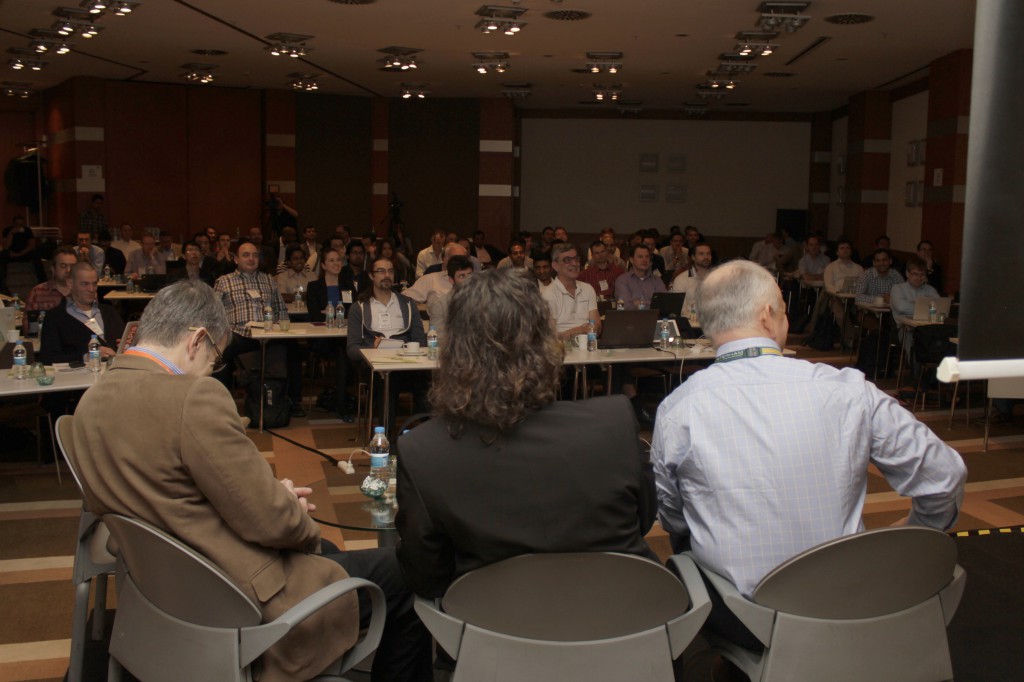 Day Two started where Day One finished, with real practical demonstrations of service innovation. In this case is was with a TADSummit Demo from Canonical, Metaswitch, Telestax and Truphone. It was a world-first demonstration of a live telephone voting service running on Ubuntu, Metaswitch and Telestax software provisioned and launched into operation over the Truphone network in front of the audience.
Day Two started where Day One finished, with real practical demonstrations of service innovation. In this case is was with a TADSummit Demo from Canonical, Metaswitch, Telestax and Truphone. It was a world-first demonstration of a live telephone voting service running on Ubuntu, Metaswitch and Telestax software provisioned and launched into operation over the Truphone network in front of the audience.
The demonstration has several ground-breaking aspects:
- First Industry-wide demo showing traffic routed from a telco into Porject Clearwater, a full cloud-based IMS (IP Multimedia Subsystem) core from Metaswitch, backed by a cluster of RestComm Telephony Application Server (TAS) featuring an API exposure layer and service creation environment from TeleStax.
- Using Ubuntu’s Cloud OS and Juju charms (orchestration) the open source software is provisioned and live in minutes. This rewrites the rules for network operators who can typically spend weeks deploying new services.
- This demo builds on the “IMS in Minutes” demonstration given at TADHack in June 2014.
- The demo was a IVR polling application which was querying Truphone HLR to playback information on the caller operator, which operator the phone is roaming on, updating a real time dashboard with location and poll results, and sending back an SMS to the caller with a voucher at the end of the demo.
- The demo was exclusively built on Open Source Software and ready in less than 2 weeks showing operators can vastly reduce infrastructure costs and focus on service innovation without incurring millions of dollars in integration costs and delays of one year in launching new services.
The components of the demo included:
- Metaswitch’s open source cloud-based IMS core, Project Clearwater;
- Telestax’s open source cloud-based telecom application server, Restcomm;
- Canonical’s Cloud OS, orchestration (Juju Charms) and live dashboard; and
- Truphone provided the mobile numbers, core network, lookups and SMS (via API).
George Held, VP Commerce, Etisalat Group and Frans De Rooij, Strategic Product Manager, Ericsson presented on the case for identities. George gave an insightful presentation that clearly demonstrated the value Etisalat’s Authentication service provides:
- Can reach 100% of the user base
- Can quickly grow to mass market: 100s of Service Providers, thousands of developers
- Shortens time to market
- Simplifies Service Provider onboarding process
- Easier to agree on common user experience (in case if accessible across other Operators)
- Easier Operator deployment (e.g., no need to integrate with CRM databases)
- Launching authentication services will drive habitual behaviour around using the mobile phone as a more secure replacement for online passwords
- Leverage Operator’s assets to obtain competitive advantage and deliver real customer value:
- Strong authentication (2-factor via mobile handset + PIN)
- Strong security (SIM storage + WPKI + secure channel)
- Identity proofing and validated attributes
- Value-add APIs/services (e.g., charge to bill)
- Retail presence and customer care
With the two example services on point of sale (Etisalat version of Square) and mobile money transfer, they can seed the market and build an ecosystem around their authentication services. In developed (slow as George called them) markets it will be more challenging, while for developing (fast as George called them) markets the case is much clearer.
Hugh Goldstein, VP Strategic Alliances, Voxbone and Daniel Forsman, COO Sinch presented on “Finding your space in the global Telecom API market.” Great presentations on the shift in communications being embedded into applications, Sinch enables this supported by Voxbone. Hugh also had a nice ecosystem diagram that showed the focus of TADS quite nicely, check out his presentation on slide 3.
Alex Economon, Director Business Development, Nexmo presented on “Powering end-user experience with communication APIs.” The focus of Nexmo is delivering B2B cloud communications. He pointed out the weaknesses in current SMS API business. With multiple hops, no quality of service, no tracking, variable read receipts. So Nexmo provides as near as possible a consistent B2B quality SMS service to reach 6.3B phones. Alex then reviewed some great case studies on how online service providers are creating world-class customer experiences using communications.
Evin Hunt, CTO Shango presented “Bridging the Ecosystem (Innovation) Gap.” Shango has a simple proposition and powerful platform that enables any phone to link action on the network to web services and vice versa. Say you want all your SMS stored in Evernote – done. Regardless of phone – it could be the simplest of 2G phones, the service works. Its a powerful concept, and was a great way to wrap-up the plenary with a new innovative platform that will create a new wave of telecom application development.

One thought on “Day Two Morning Plenary, TADSummit Demo”
Comments are closed.